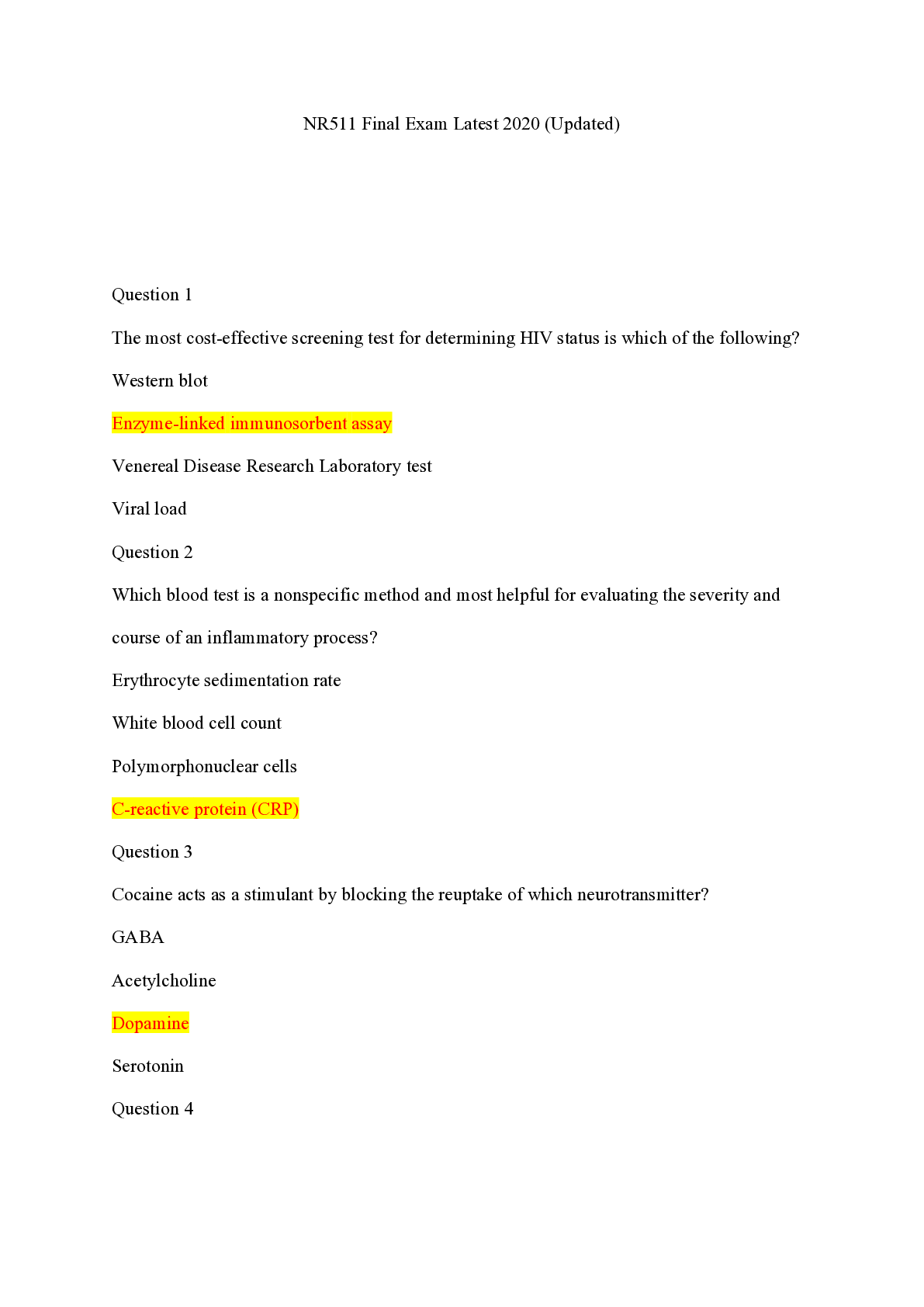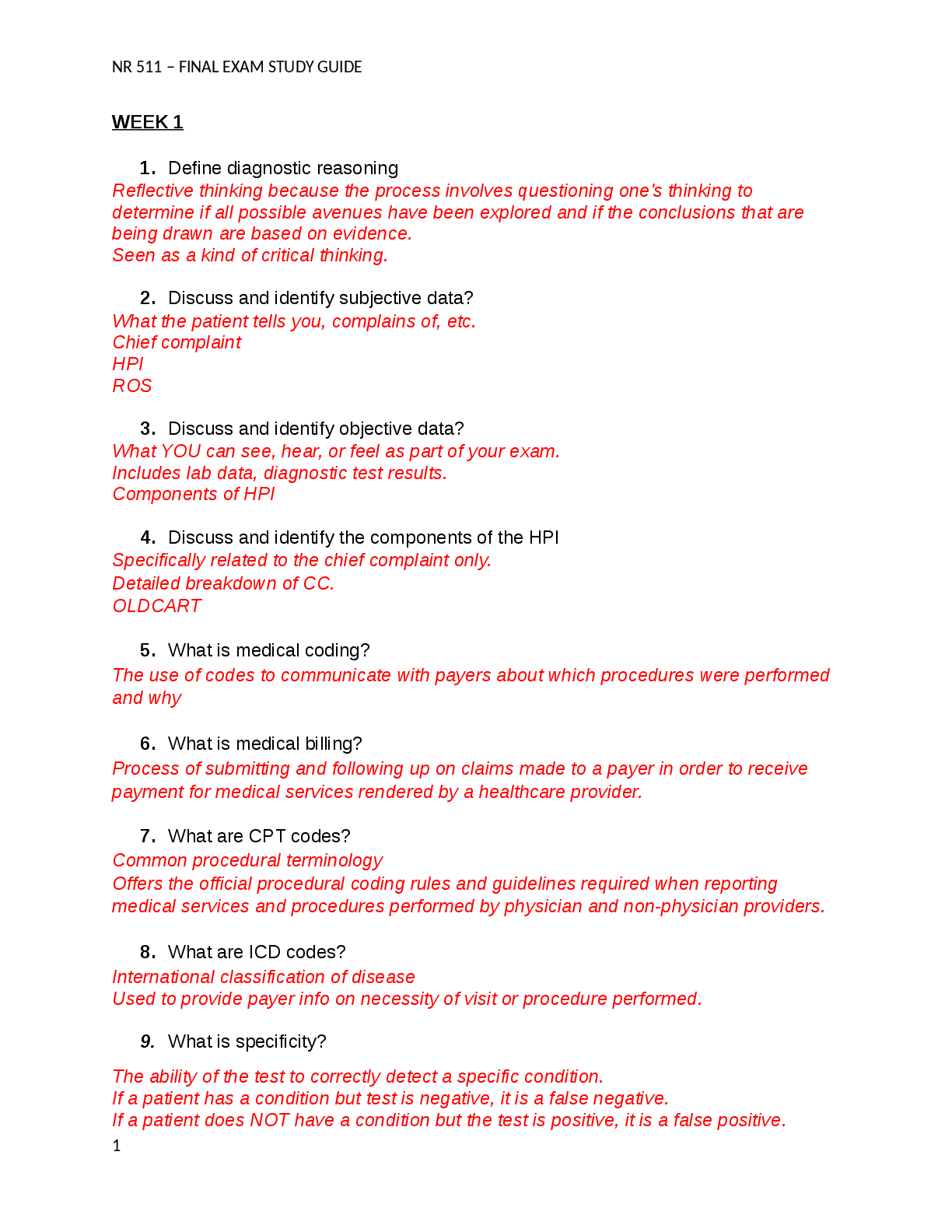NR 511 / NR511 FINAL EXAM 1
Document Content and Description Below
The effectiveness of benzodiazepines in treating anxiety disorders suggests that which of the following neurotransmitters plays a role in anxiety? Gamma-aminobutyric acid (GABA) The criteria for di... agnosing generalized anxiety disorder in the American Psychiatric Associations Diagnostic and Statistical Manual of Mental Disorders, 5th edition (text revision) state that excessive worry or apprehension must be present more days than not for at least? 6 months A 20-year-old woman is seen in the clinic because her boyfriend was found to have gonorrhea. Which of the following is the treatment of choice for gonorrhea? a. Ceftriaxone b. Doxycycline c. Acyclovir d. Metronidazole Ceftriaxone A patient is seen in the clinic with a chief complaint of hematuria. To make a differential diagnosis, which of the following questions should be asked? a. "Do you have a history of liver disease?" b. "What medications are you currently taking?" c. "Have you noticed swelling in your ankles?" d. All of the above "What medications are you currently taking" A patient is seen in the clinic with hematuria confirmed on microscopic examination. The clinician should inquire about the ingestion of which of these substances that might be the cause of hematuria? a. NSAIDs b. Beets c. Vitamin A d. Red meat NSAIDS A 27-year-old female presents with a chief complaint of burning and pain on urination. She has no previous history of urinary tract infection (UTI). What are some additional symptoms consistent with a diagnosis of lower UTI? a. Back and abdominal pain b. Fever, chills, costovertebral angle (CVA) tendernessc. Blood in urine and frequency d. Foul-smelling discharge, perineal itch Blood in urine ad frequency A 30-year-old patient presents with pain on urination. The urine microscopy of unspun urine shows greater than 10 leukocytes/mL, and a dipstick is positive for nitrites. What is the probable diagnosis? a. Lower urinary tract infection b. Chlamydia infection c. Candidiasis d. Pyelonephritis Lower urinary tract infection A patient presents with CVA tenderness and a several-day history of high fever, chills, and dysuria. Which of the following diagnoses is most likely given the above information? a. Pyelonephritis b. Cystitis c. Renal calculi d. Bladder tumor Pyelonephritis A patient is diagnosed with urge incontinence. Before prescribing Detrol XL, the provider should question the patient about which of these contraindications to this medication? a. Diarrhea b. Parkinson's disease c. Closed-angle glaucoma d. Breast cancer Closed-angle glaucoma A patient is seen in the office complaining of severe flank pain. The clinician should assess this patient for which risk factor for kidney stones? a. Hypertension b. Constipation c. Tubal ligation d. Diabetes Hypertension A patient is diagnosed with overactive bladder. Which of the following instructions should be given to this woman? a. "Limit the amount of water that you drink." b. "Eliminate caffeine from your diet." c. "Wear panty liners." d. All of the above Eliminate caffeine from your dietA 34-year-old patient was treated for a UTI and has not responded to antibiotic therapy. Which of the following actions should be taken next? a. Send a urine specimen for microscopy and evaluate for fungal colonies. b. Increase the dose of antibiotic. c. Order a cytoscopy. d. Order a different antibiotic. Send a urine specimen for microscopy and evaluate for fungal colonies Which of the following are predisposing factors for pyelonephritis? a. Pregnancy b. Dehydration c. Smoking d. Alkaline urine Pregnancy A 42-year-old woman is seen in the clinic with fever, chills, vomiting, and severe dysuria. She is diagnosed with acute pyelonephritis. How should this patient be managed? a. 3-day course of oral antibiotics b. Hospitalization c. Encourage cranberry juice intake. d. 6-week course of antibiotics Hospitalization Oral antibiotics may be prescribed in mild cases of acute pyelonephritis, characterized by the absence of nausea and vomiting or signs of sepsis. First-line therapy includes ciprofloxacin (Cipro) 500 mg two times daily for 7 days, or ciprofloxacin extended-release (Cipro XR) 1,000 mg daily for 7 days, or levofloxacin (Levaquin) 750 mg daily for 5 days. Hospitalization may be indicated, depending on the patient's ability to maintain adequate fluid intake and to tolerate oral antibiotics, along with the severity of the symptoms and evidence of bacteremia. Hospitalization of patients who are pregnant, vomiting, or dehydrated should be strongly considered. Likewise, the patient's degree of systemic illness (bacteremia or urosepsis), age, history of chronic disease, or nonadherence to therapy may lead to the assessment that hospitalization is necessary. Ninety- five percent of patients demonstrate a good response within 48 hours to IV antibiotic treatment and may be discharged on appropriate oral medication, once urine culture and antibiotic sensitivity results are available and subsequent antimicrobial therapy may be narrowed in spectrum. A patient is seen with a sudden onset of flank pain accompanied by nausea, vomiting, and diaphoresis. In addition to nephrolithiasis, which of the following should be added to the list of differential diagnoses? a. Pancreatitis b. Peptic ulcer diseasec. Diverticulitis d. All of the above All of the above Which of the following instructions should be given to the patient with nephrolithiasis? a. Take ibuprofen, 600 mg every 8 hours. b. Take Tums® for stomach upset. c. Drink more black tea. d. Increase intake of vegetables, like spinach. Take ibuprofen, 600 mg every 8 hours Which of the following patients is at risk for developing urinary tract cancer? a. The 45-year-old woman who is 100 lbs overweight b. The 78-year-old man who smokes three packs of cigarettes a day c. The 84-year-old man who worked in the asbestos mines d. All of the above All of the above Obesity; exposure to asbestos, cadmium, and/or gasoline; the use of phenacetin- and aspirin-containing analgesics; and chronic hemodialysis for acquired polycystic kidney disease are all risk factors for renal cell carcinoma. Cigarette smoking has a 25% to 30% correlation with the development of renal cell carcinoma. An 86-year-old woman is seen in the clinic for recurrent hematuria. The provider suspects bladder cancer. Which of the following data from the history is considered a risk factor for this type of cancer? a. History of alcoholism b. Sedentary lifestyle c. Obesity d. 65-year smoking history 65-year smoking history Which of the following diagnostic tests should be ordered for a patient suspected of having bladder cancer? a. Kidneys, ureter, bladder x-ray b. Cystoscopy with biopsy c. Magnetic resonance imaging d. Urine tumor marker (NMP22) Cystoscopy with biopsy A 78-year-old man is diagnosed with Stage D bladder cancer and asks the provider what that means. Which is the best response? a. "There is no such thing as Stage D cancer." b. "You have cancer that has spread to the surrounding tissue."c. "Your cancer has spread to other organs." d."Your cancer can be cured by removing your bladder." "Your cancer has spread to other organs" In general, TRANSITIONAL CELL CARCINOMAS are staged from A to D, according to level of invasion: stage 0 tumors are confined to the mucosa; stage A tumors invade the lamina propria; stage B tumors invade the muscular layer; stage C tumors extend to the peripelvic fat or renal parenchyma; and stage D indicates metastatic disease. The tumor-node-metastasis (TNM) system of the American Joint Committee on Cancer may also be used, with nodal metastases reflecting stage IV cancer. When transitional cell carcinomas are looked at as a whole, in situ disease has a 5-year survival rate of 95%, localized disease nearly 90%, regional disease just over 60%, and distant disease only 17% Hematuria differential diagnosis include? UTI, pylyonephritis, cancer, BPH Hematuria physical exam should include? Abdominal exam, tenderness, massess, CVA tenderness, pelvic/prostate exam Diagnostic tests needed in evaluation of hematuria? UA, C&S, CMP, BMP, IVP intravenous pyelogram, cystoscopy, US, CT scan Hematuria management and follow-up If bacterial such as UTI- antibiotic therapy **if not further evaluation refer to urology or nephrology Lower UTI occurs where? urethra, bladder, prostate Most common pathogen of UTI includes? E.coli Clinical presentation of UTI S/S? dysuria, urinary frequency/urgency, nocturia, hematuria, low back or suprapubic pain, urinary incontinence, foul smelling urine **elderly alterned mental status may be only manifestation!What diagnostic tests would one use for UTI? Clean catch urine sample showing presence of bacteria **>100 organisms/ml with presence of clinical symptoms *Urine culture may be indicated if complicated infection is suspected, if atypical symptoms are present or if symtpoms persist or recur within a month of pt recieving empiric course of antibiotics. What antibiotics would be prescribed for an uncomplicated UTI? Bactrim (TMP-SMP) 160/800 mg BID for 3 days **for pts with no drug allergies, previous hospitalization or antibioitc use in 3 months Macrobid (Nitrofurantoin) 100 mg BID x 7 days used as an alternative for pts with sulfa allergies or those with previous antibiotics within last 3 months Fluoroquinolones such as Cipro 250 mg BID x 3 days or levaquin 250 mg daily x 3 days What would you treat a patient with a fungal UTI? What is usually the cause? Diflucan (Fluconazole) 200 mg PO daily for 7-14 days. **usuallyis associated with indwelling catheter ALMOST HALF CASES RESOLVE ON THEIR OWN WHEN CATHETER IS REMOVED AND does not need treatment. What is pyelonephritis? infection of the kidney that is characterized by infection within renal pelvis, tubules, or interstial tissue that may be unilateral or bilateral What are the pre-disposing risk factors for pyelonephritis? a. Pregnancy b. Dehydration c. Smoking d. Alkaline urine Pregnancy increased in patients with predisposing factors including anatomical abnormalities such as ureterovesical reflux, urinary obstruction, stress incontinence, multiple or recurrent urinary tract infections (UTIs), renal disease, kidney trauma,pregnancy, and metabolic disorders such as diabetes mellitus. What are the signs and symptoms of acute pylonephritis sudden onset of fever, shaking, chills, n/v, unilateral or localized flank pain, fatigue, diarrhea **largely asymptomatic **elderly pts with altered mentation What can be seen on physical exam for pylonephritis? marked tenderness on deep abdominal palpation **may be hypertensive. Diagnostics needed for pylonephritis? dx confirmed through UA (positive for bacteria, proteinuria, leukocytes esterase, urinary nitrates, hematuria, pyuria, WBC CASTS (passage through nuetrophils thorugh renal tubules) **Urine culture >100,000 cfu/ml (allowing for identification of causitive organism) **MOST IMPORTANT is WBC CASTS *cystoscopy with ureteral catheterization, renal ultrasound, intravenous pyelogram What assessment is performed to try and diagnose pylonephritis? physical exam: Tenderness on deep palpation/percussion of CVA tenderness (back) ** pts may be hypertensive What antibiotics should be used for pyleonephritis? Cipro 500 mg BID for 7 days Cipro XR 1000mg daily for 7 days Levaquin 750 mg daily for 5 days TX for kidney stones include? pain relief (oral NSAIDS, opiates, antispasmodics, warm compresses, focused breathing diversional therapy) *thiazide diuretics (calcium) Allopurinol (uric acid) D penicillamine (cystine) increase water intake noninvasive and invasive surgical interventionsAVOID TUMS, loop diuretics, vitamin supplements Stress incontinence can be brought on easily by? coughing sneezing, straining Management of stress incontinence includes? kegals 40-60 contractions daily (slow tighten 10 seconds, hold 10 seconds, release over 10 seconds) Pelvic floor muscle training Vaginal cones or pessaries lose wt limit fluids in evening MEDS: vaginal estrogen Surgical intervention Over Active Bladder medications include? Anticholinergic/Antimuscarinic medications Oxybutynin- Ditropan and XL PO or patch Tolterodine (Detrol and Detrol LA) Side effects: dry mouth, constipation, blurred vision The result of the patient's 24-hour urine for protein was 4.2 g/day. The clinician should take which of the following actions? a. Repeat the test. b. Refer to a nephrologist. c. Measure the serum protein. d. Obtain a blood urea nitrogen (BUN) and creatinine. Refer to a nephrologist. If the excretion rate is above 3.0 to 3.5 g/day, the patient, by definition, has nephrotic syndrome and must be referred to a nephrologist. Can lead to AKI, End stage renal failure and hypertensionA patient is seen complaining of "leaking urine when I sneeze." Which of the following actions should the clinician take first? a. Order a cystometrogram. b. Obtain a computed tomography scan. c. Instruct the patient on Kegel exercises. d. Prescribe imipramine. Instruct the patient on Kegel exercises. Which of the following information is essential before prescribing Bactrim DS to a 24-year-old woman with a UTI? a. Last menstrual period b. Method of birth control c. Last unprotected sexual contact d. All of the above All of the above Certain patterns of pain, numbness, and tingling are associated with carpal tunnel syndrome. Katz hand diagram Tinel sign Median nerve integrity Tinel sign is tested by striking the patient's wrist with your index or middle finger where the median nerve passes under the flexor retinaculum and volar carpal ligament. A tingling sensation radiating from the wrist to the hand in the distribution of the median nerve is a positive Tinel sign and is suggestive of carpal tunnel syndrome. Median Nerve Integrity/ Carpal Tunnel testing Tinel sign, Phalen, Thumb abduction Thumb abduction Have the patient place the hand palm up and raise the thumb perpendicular to it. Apply downward pressure on the thumb to test muscle strength. Full resistance to pressure is expected. Weakness is associated with carpal tunnel syndrome. Phalen test To perform the Phalen test, ask the patient to hold both wrists in a fully palmar-flexed position with the dorsal surfaces pressed together for 1 minute Numbness and paresthesia in the distribution of the median nerve are suggestive of carpal tunnel syndrome. [Show More]
Last updated: 2 years ago
Preview 1 out of 30 pages

Buy this document to get the full access instantly
Instant Download Access after purchase
Buy NowInstant download
We Accept:

Reviews( 0 )
$18.00
Can't find what you want? Try our AI powered Search
Document information
Connected school, study & course
About the document
Uploaded On
Aug 28, 2021
Number of pages
30
Written in
Additional information
This document has been written for:
Uploaded
Aug 28, 2021
Downloads
0
Views
43

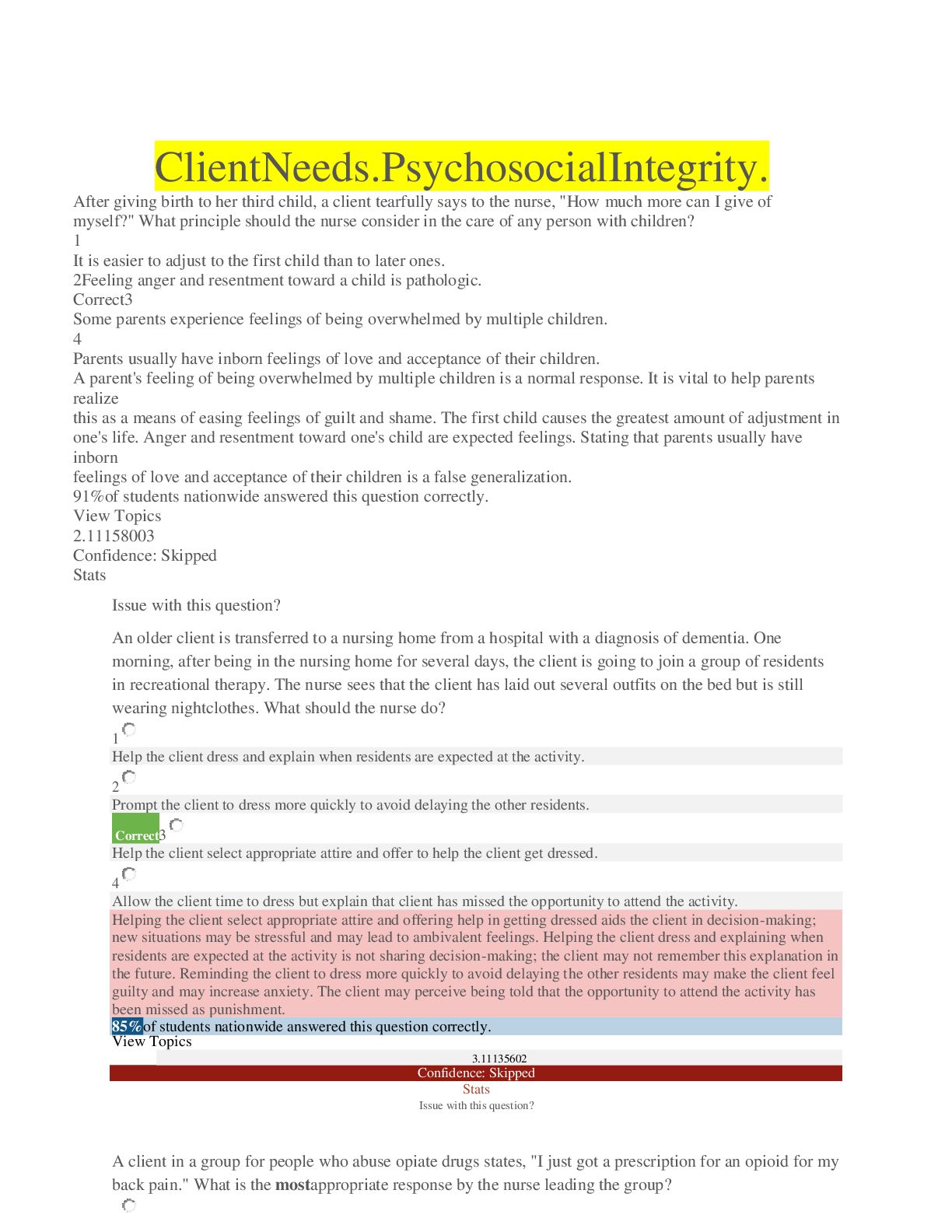



.png)
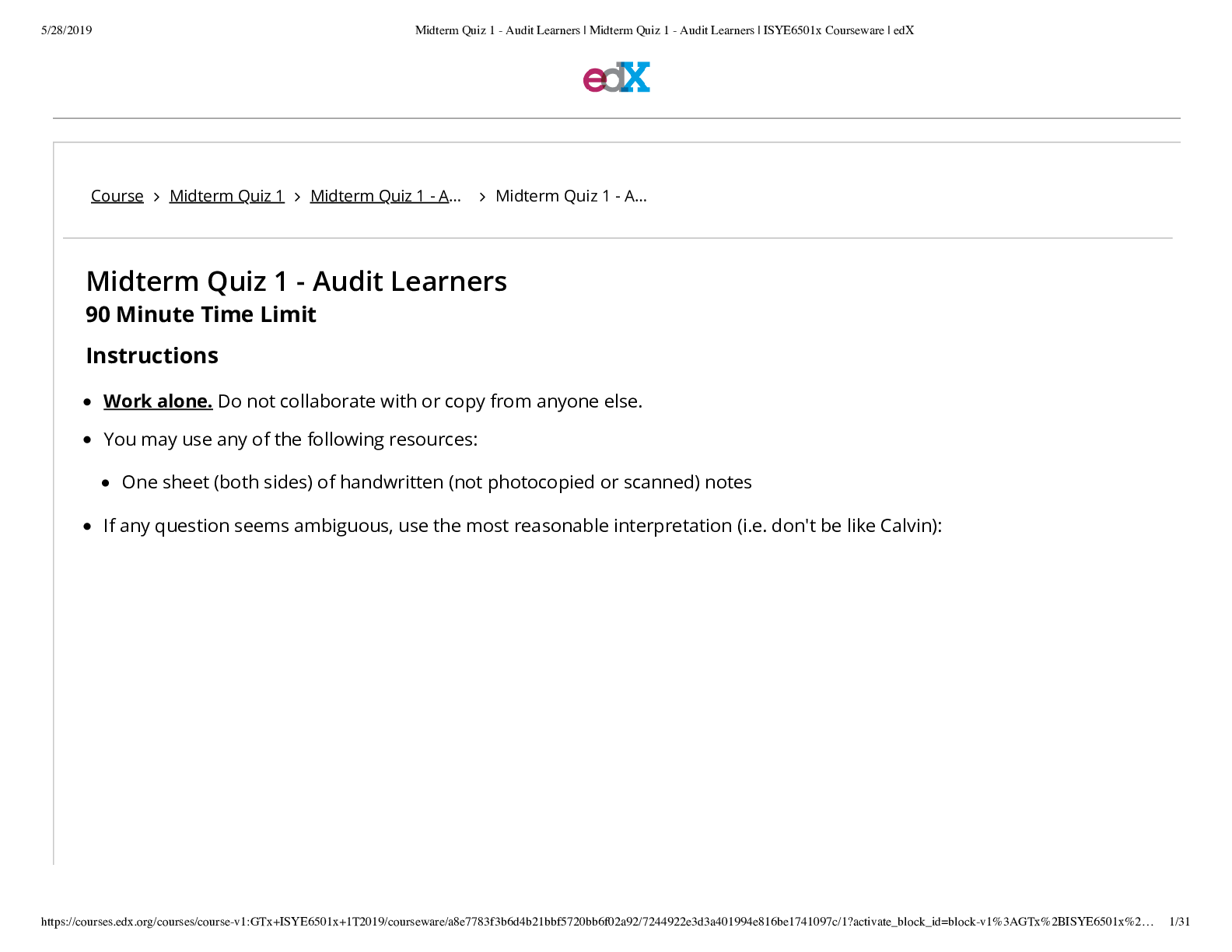
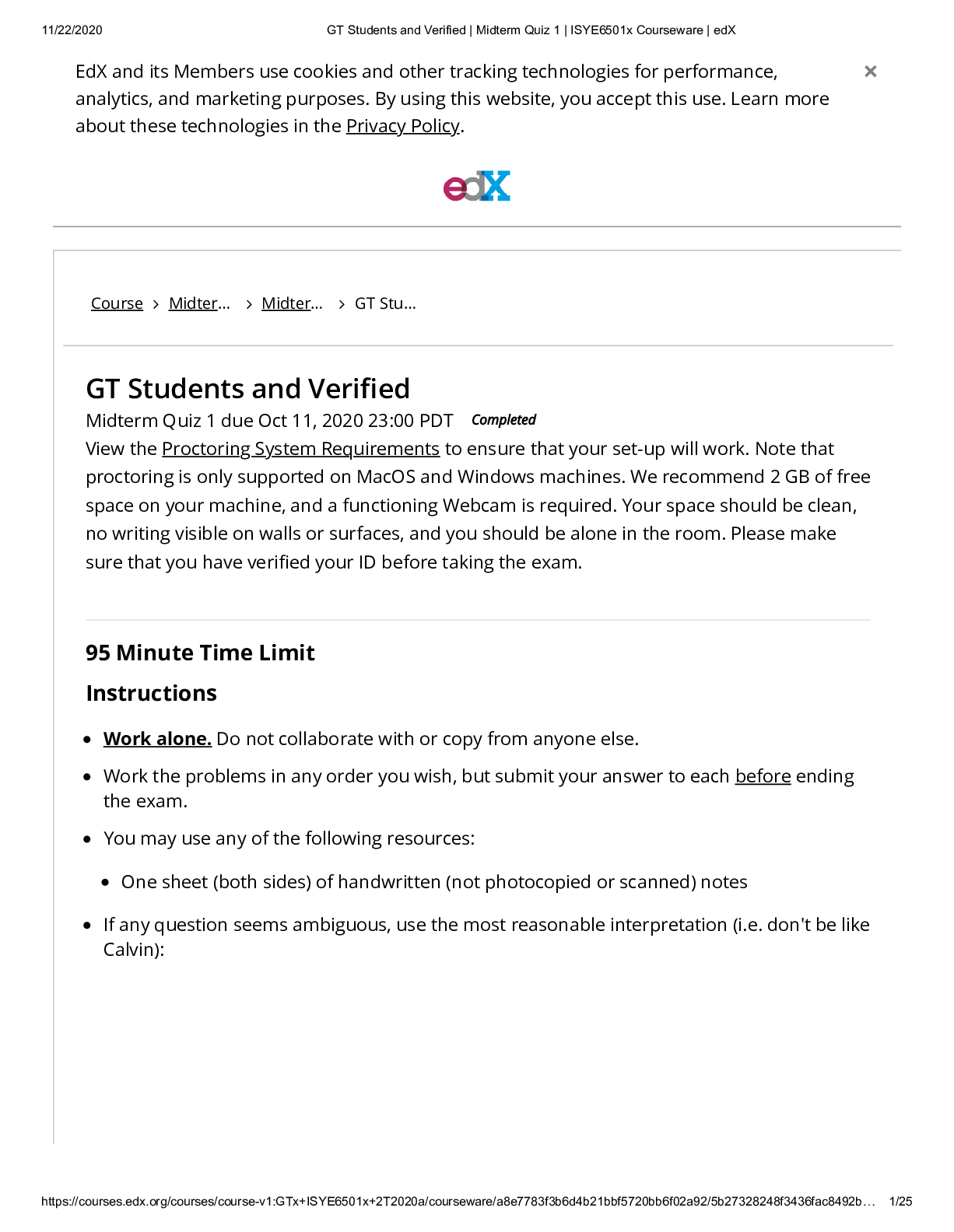

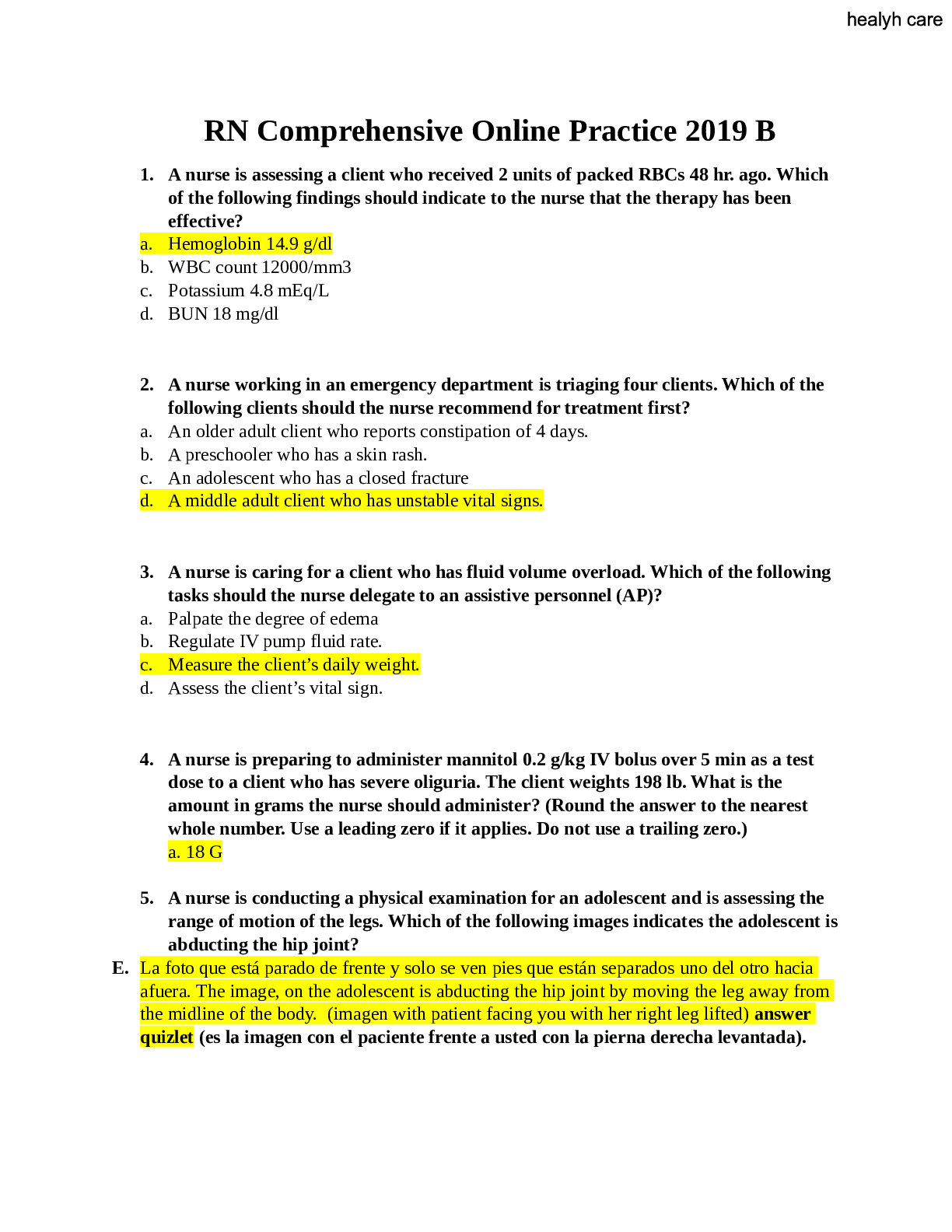
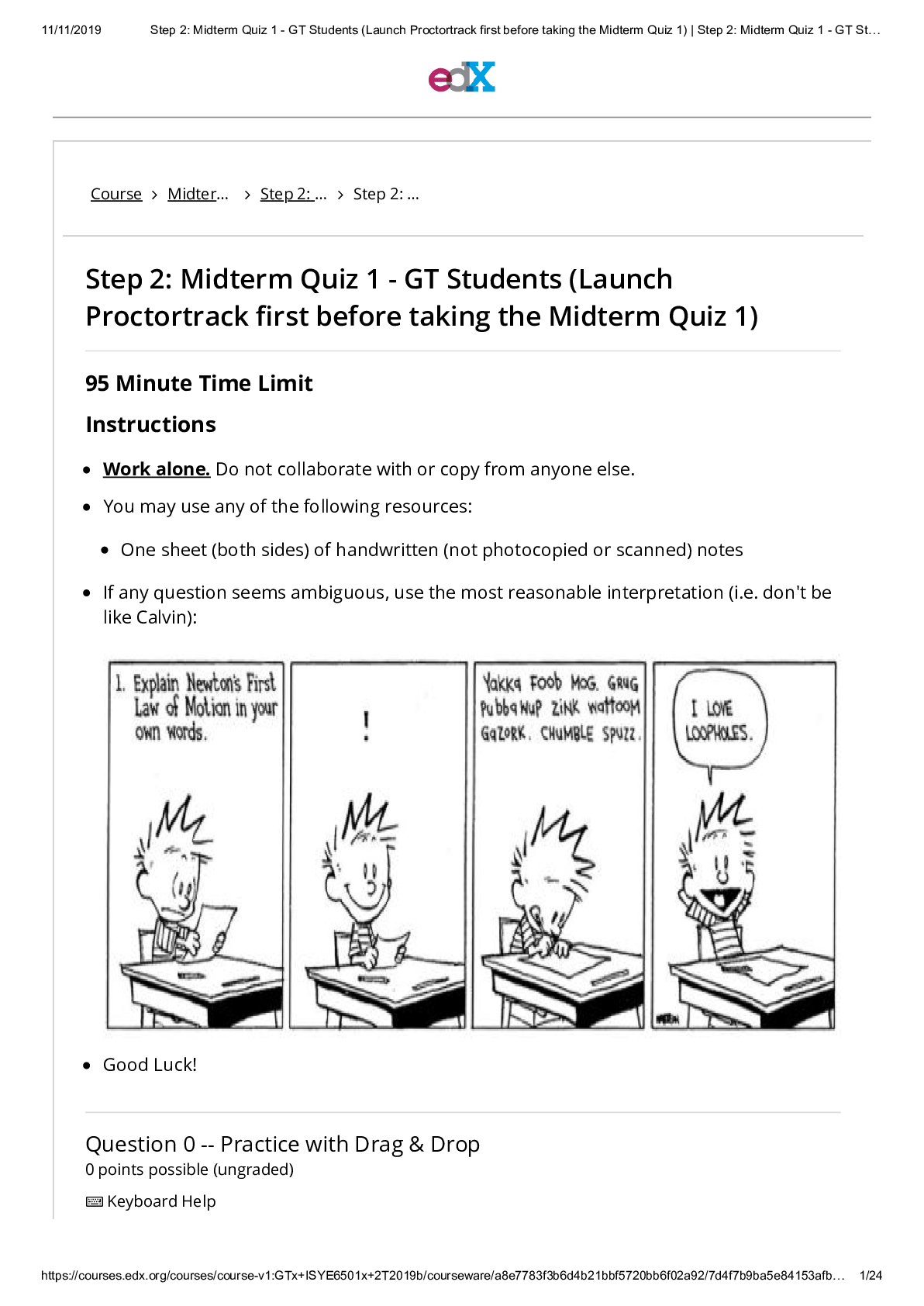
.png)
.png)


